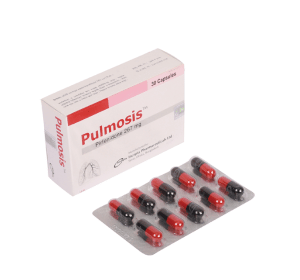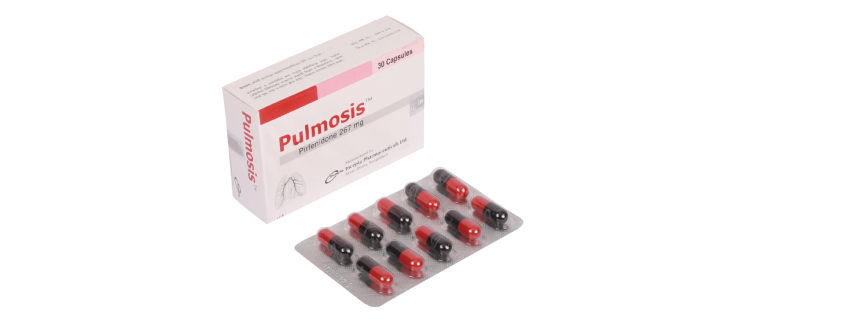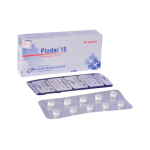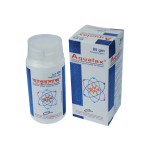Pulmosis(Pirfenidone)
Therapeutic Group: Anti-fibrinolytic

Presentation
Pulmosis 267 capsule: Each capsule contains Pirfenidone BP 267 mg.
Pulmosis 267 tablet: Each tablet contains Pirfenidone BP 267 mg.
Pulmosis 534 tablet: Each tablet contains Pirfenidone BP 534 mg.
Pulmosis 801 tablet: Each tablet contains Pirfenidone BP 801 mg.
Description
Pirfenidone is an anti-fibrotic drug for the treatment of idiopathic pulmonary fibrosis (IPF). It is assumed that it works by reducing lung fibrosis through down regulation of the production of growth factors and procollagens. IPF is a condition in which the tissues in lungs become swollen and scarred over time and as a result makes it difficult to breathe deeply. This makes it hard for lungs to work properly. Pirfenidone helps to reduce scarring and swolling in the lungs, and helps breathe better
Indications
Pirfenidone is indicated for the treatment of idiopathic pulmonary fibrosis
Dosage & Administration
1.Recommended dosage: The recommended daily maintenance dosage of pirfenidone is 801 mg (1 Tablet/3 capsules) three times daily taken with food. Doses should be taken at the same time each day.
2.Upon initiation of treatment, the daily dosage should be titrated to the full dosage of 3 Tablets/9 capsules per day over a 14-day period as follows:
Days 1 through 7 is 267 mg (1 capsule) three times a day with meals
Days 8 through 14 is 534 mg (2 capsules) three times a day with meals
Days 15 onward is 801 mg (1 tablet/3 capsules) three times a day with meals
3.Dosages above 2403 mg/day (3 tablets/9 capsules per day) are not recommended for any patient. Patients who miss 14 or more days of pirfenidone should be re-initiate treatment by undergoing the initial 2 week titration regimen up to full maintenance dosage. For the treatment interruption of less than 14 days, the dosage prior to the interruption can be
resumed.
Side Effects
The most common adverse reactions are nausea, rash, abdominal pain, upper respiratory tract infection, diarrhea, fatigue, headache, dyspepsia, dizziness, vomiting, anorexia, gastro-esophageal reflux disease, sinusitis, insomnia, weight decreased, and arthralgia etc
Precautions
1. Elevated liver enzymes: ALT, AST, and bilirubin elevations have occurred with Pirfenidone. Monitor ALT, AST and bilirubin before and during treatment. Temporary dosage reductions or discontinuations may be required.
2. Photosensitivity and rash: Photosensitivity and rash have been noted with Pirfenidone. Avoid exposure to sunlight and sunlamps. Wear sunscreen and protective clothing daily. Temporary dosage reductions or discontinuations may be required.
3. Gastrointestinal disorder: Gastrointestinal events of nausea, diarrhea, dyspepsia, vomiting, gastro-esophageal reflux disease and abdominal pain are more frequently reported by patients in the treatment with Pirfenidone
Use in Pregnancy & Lactation
Pregnancy category C. There are no adequate and well-controlled studies in pregnant women. It is not known whether it is excreted in human milk.
Use in specific population
No dosage adjustment is required for geriatric patient. Pirfenidone should be used with caution in patients with mild to moderate hepatic and renal impairment. There is no relevant use of Pirfenidone in the paediatric population for the indication of IPF
Drug Interaction
The concomitant administration of Fluvoxamine, Ciprofloxacine or other strong and moderate CYP1A2 inhibitors with Pirfenidone are not recommended because they significantly increase exposoure to pirfenidone.
Storage
Do not store above 30°C. Keep away from light and out of the reach of children.
Commercial Pack
Pulmosis 267 capsule: Each box contains 3 blister strips of 10 capsules.
Pulmosis 267 tablet: Each box contains 3 blister strips of 10 tablets.
Pulmosis 534 tablet: Each box contains 2 blister strips of 10 tablets.
Pulmosis 801 tablet: Each box contains 1 blister strip of 10 tablets



